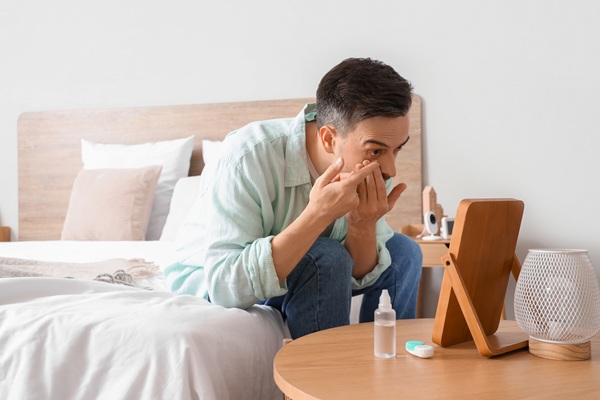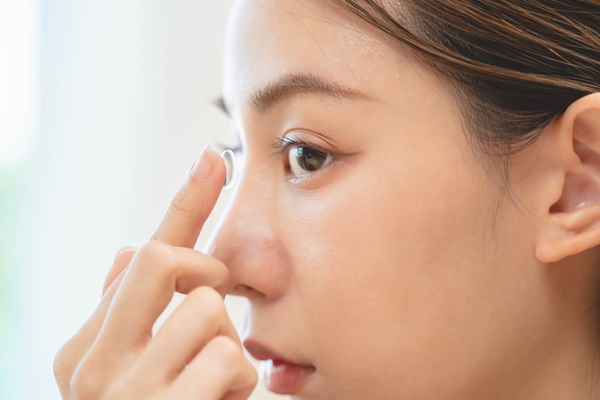A Beginner’s Guide To Wearing Prescription Contacts

Prescription contacts provide vision correction, comfort, and convenience for those who do not want to wear glasses. However, caring for and wearing contacts takes some getting used to. Learning to insert, remove, and maintain them will help ensure a comfortable and safe experience.
Choosing the right prescription contacts
Not all contact lenses are the same, and choosing the right pair is important for comfort and vision. An optometrist will determine the most appropriate type of prescription contacts based on a person’s specific vision needs and eye health.
Soft Lenses
Soft contact lenses are made of flexible, water-absorbing materials that allow oxygen to reach the eyes. They are comfortable to wear and easy to adjust to, making them a popular choice for beginners. These lenses are available daily, biweekly, and monthly, depending on the wearer’s needs.
Rigid Gas Permeable (RGP) Lenses
RGP lenses have a firmer material that provides clearer vision, especially for people with astigmatism or other complex prescriptions. They allow more oxygen to pass through than traditional hard lenses but require a longer adjustment period. These lenses are more durable than soft lenses and can last months or even years with proper care.
Daily Disposable Lenses
These lenses are designed for single use and are thrown away at the end of each day. They provide a fresh, clean pair every morning, reducing the risk of eye infections caused by improper cleaning. Daily disposable lenses are a great option for those who want a low-maintenance and hygienic choice.
Extended Wear Lenses
Patients need to wear extended-wear lenses continuously, including overnight, for a specified number of days. While these lenses use breathable materials that allow oxygen to reach the eyes, they still require careful monitoring. An optometrist must determine if extended-wear lenses are safe based on a person’s eye health and lifestyle.
Inserting and removing contact lenses
Putting in and taking out contact lenses can feel difficult at first, but with practice, it becomes easier. Always wash the hands thoroughly before handling the lenses, and dry the hands with a lint-free towel. With practice, inserting and removing contacts will become a quick and easy process.
Inserting contact lenses
Place the lens on the tip of the index finger and check that it is not inside out. Then, use the other hand to carefully hold the upper eyelid while pulling down the lower eyelid with the middle finger of the same hand holding the lens. Look straight ahead, place the lens on the eye, and blink a few times to help settle it into place.
Removing contact lenses
With clean and dry hands, look up and gently pull down the lower eyelid. Use the index finger and thumb to pinch the lens and remove it. Then, place the lens in a clean contact lens case or dispose of it if using daily lenses.
Caring for contact lenses
Proper contact lens care is necessary to maintain eye health and prevent infections. Following the right steps will keep the lenses clean and comfortable.
- Always wash hands before handling contact lenses.
- Use only the contact lens solution recommended by the optometrist.
- Never rinse or store lenses in water, as this can introduce bacteria.
- Replace contact lenses as directed, whether daily, biweekly, or monthly.
- Clean and replace the contact lens case regularly to prevent bacteria buildup.
- Avoid sleeping in contact lenses unless approved by the optometrist.
Never use saliva or tap water to clean lenses, or wear the lenses longer than recommended. Contact wearers should avoid excessive eye rubbing while wearing lenses and never ignore symptoms of discomfort, redness, or blurry vision. If problems occur, contact an optometrist for advice.
Getting prescription contacts from a licensed optometrist
It is important to get prescription contacts from an optometrist rather than purchasing them without a professional fitting. Contact lenses are medical devices that require a proper prescription to ensure they fit correctly and do not harm the eyes.
An optometrist provides several benefits, including:
- Accurate prescription. A professional eye exam determines the correct lens power for clear vision
- Proper fit. Poorly fitted contacts can cause discomfort, blurry vision, or eye damage
- Eye health check. An optometrist ensures there are no underlying conditions that could make wearing contacts unsafe
- Safety and comfort. A professional fitting helps prevent irritation and infections
Visiting an optometrist helps ensure a positive experience with contact lenses while protecting long-term vision and eye health.
Healthy vision starts with proper contact lens care
Need vision correction but not a fan of wearing glasses? Make an appointment with an optometrist to learn if prescription contacts are for you. By following the right steps, anyone can enjoy the benefits of contact lenses while keeping their eyes healthy.
Request an appointment here: https://www.texasoptical.net or call Texas Optical at (214) 771-7333 for an appointment in our Dallas office.
Check out what others are saying about our services on Yelp: Read our Yelp reviews.
Recent Posts
For those living with diabetes, undergoing a diabetic eye exam is one of the most important steps in protecting their vision and overall eye health. High blood sugar levels can lead to a range of complications, including conditions that damage the eyes over time. These exams help detect these issues before they become serious, allowing…
Contact lenses provide clear vision and convenience for individuals who prefer an alternative to eyeglasses. However, proper care and maintenance are essential to prevent infections, irritation, and eye damage. Neglecting hygiene practices can lead to serious eye conditions, including corneal ulcers and keratitis. Understanding how to clean, store, and handle contact lenses ensures long-term eye…
Maintaining eye health and preventing long-term issues is the result of consistent and quality vision care. Many people focus on overall wellness but may overlook daily habits that support healthy eyesight. However, taking simple steps each day can protect vision, reduce eye strain, and prevent future complications. By making eye health a priority, it is…
If you are thinking about seeing an optometrist, you should first look at your options. When you understand what this doctor does, you can make the right choice for your eye health. Other medical professionals help patients with their eyes too. So, it is important that you get the relief and treatment you need.People depend…


